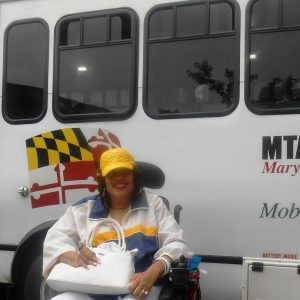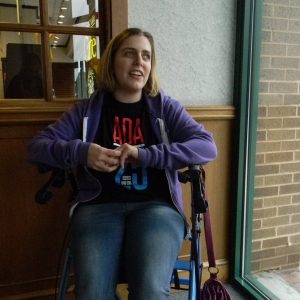BALTIMORE — Janice Jackson sat outside Walmart waiting. She had a ride scheduled with Maryland Transit Administration’s Mobility, the paratransit service for people with disabilities in the Baltimore area, to pick her up at 2:30 p.m. so she could make it to a meeting in Towson.
She waited the 30-minute leeway, and at 3 p.m. she rang Mobility’s call center to inquire about her late ride.
“They said it would be there in 10 minutes,” Jackson, 55, said. It wasn’t.
About four and half hours later, after the call center continued to tell Jackson 5 or 10 more minutes, after a phone call and visit with the police, after her phone died and she soiled her pants for fear of missing her ride to go inside to use the bathroom—a Mobility bus picked her up. She missed her meeting by hours.
“In 31 years, this is the worst I’ve ever seen Mobility,” said Jackson, who is an incomplete quadriplegic and executive director of Women Embracing Abilities Now, a mentoring program for young women with disabilities that focuses on their abilities. “We are in the process of being neglected and abused by the system every day.”

And she is not alone.
The Maryland Disability Law Center and the AARP Foundation filed a class action lawsuit in January against the state’s transit administration and the Maryland Department of Transportation for improperly denying eligibility and access to paratransit services, thus a violation of the American with Disabilities Act.
What is Mobility?
Because of her disability, Jackson is one of about 25,000 residents who are qualified and certified to use Maryland Transit Administration’s Mobility services as an alternative to fixed-route systems, like the local bus, light rail system or metro/subway lines. A paratransit option is federally mandated under the ADA to provide comparable transportation for people with disabilities.
Mobility buses operate in Baltimore City, Anne Arundel County and Baltimore County anywhere within ¾ of a mile radius of a fixed-route transportation system.
Riders are supposed to pre-schedule their rides, either with the Mobility call center or through an online system, which has a program that works to organize about 7,000 daily rides. Each ride isn’t considered late until it extends beyond the 30-minute scheduling window.
“I think we’re doing well but we can do better,” said Dan O’Reilly, MTA Mobility director. “We just got through a couple bad months, the weather was the definite impact.”
The on-time performance goal for Mobility is 90 percent, which the service regularly meets, said Rob Barnes, senior deputy administrator for MTA. Barnes served as the interim MTA administrator until Gov. Larry Hogan’s appointee, Paul Comfort, took over the position May 11. But in the last few months the on-time performance percentage has dropped to the low- to mid-80s, Barnes said.
“We are proud of the services we offer, serving the 7,000 trips every day. Yes, there are areas of improvement,” Barnes said.

The parties to the lawsuit have been in settlement talks for weeks, and are expected to continue, Maryland Disability Law Center litigation director Lauren Young said, but no one can comment on the status of the case. Representatives from the transit agency also declined to comment on the lawsuit.
The lawsuit focuses on two issues: the certification procedure clients must go through to use Mobility, and its phone services. Young explained that a flawed re-certification process has been denying people the service who desperately need it, and busy, long holds or dropped calls make scheduling rides impossible.
“It’s critical for people, so what’s promised to them under the law is what we want,” Young said.
However, Barnes and O’Reilly talked about some of their proposed improvements, like the addition of 36 new Mobility buses to the fleet of more than 400, getting a health check on their scheduling system and expanding their call center to increase staff by 20 percent.
“It’s a matter of implementing those and most importantly (making sure they are) executed and monitored,” Barnes said.
Comfort has a background in paratransit services from a previous job as assistant project manager and director of operations for MV Transportation, which was contracted by the Washington Metropolitan Area Transit Authority’s paratransit option, MetroAccess, and is one of the three contractors for Mobility.
“My goal is to make sure that the new resources MTA has invested in Mobility are used as effectively and efficiently as possible as we continue to meet increasing demands for paratransit services,” Comfort wrote in an email.
Beyond Complaints
MTA Mobility has a system in place to take, respond and react to complaints, O’Reilly said, but after listening to customers at a monthly Citizens Advisory Committee for Accessible Transportation on April 16, O’Reilly said he needs to follow up with the customer service manager because people said they never hear back.
The service received more than 15,000 complaints since 2012, the majority of which focused on a no-show ride or a late ride, but many people also complained about a discourteous vehicle operator or a scheduling issue.
“We take those complaints very seriously; as a part of our process we want to know the details of every one because we investigate each and every complaint,” Barnes said.
Over the past four years, the relative number of complaints per every ride has slowly decreased, as the annual number of rides has continued to increase: The complaints remain around 4,000 each year.
But for some people, complaining has become useless.
“We never got a call back, never get feedback, but the problems still exist,” Jackson said. “We are beyond filing complaints.”
Call for Action
In more than three decades of riding Mobility, Jackson said, this is the first time she’s ever felt the need to really stand up for her rights—because she said she cannot “let them win.”
“No other service in MTA would take this abuse, there has to be something done,” she said. “It’s our lifeline, without paratransit, we couldn’t do anything, work, doctors, appointments… the use of transportation is our livelihood.”
President and CEO of the League for People with Disabilities David Greenberg said Mobility is a great service for many Marylanders giving people the opportunity to work and socialize and participate in civic affairs, but he said right now it is struggling to meet the needs of its customers.
“There are some problems with Mobility that have worsened over the last year or 18 months,” Greenberg said.
Jackson has decided to form the MTA Coalition—creating a new acronym for the letters: “Make Them Accountable.” She said she is forming partnerships with all different kinds of groups who are affected by Mobility’s shortcoming to make a real difference.
Jackson’s first rally for the coalition was on May 2 at the World of Possibilities Expo in Baltimore, where she hoped to call attention to the issue and gain excitement for their movement, she said. She hopes to eventually call the attention of the governor, legislators, and taxpayers to the injustices in Mobility.
“Everybody needs to put this on their radar,” Jackson said. “It’s going to take a village, we’re going to make a difference now.”
‘I don’t have many as many problems’
Cheryl Gottlieb, 30, has been fighting Mobility, trying to hold them accountable, for months. She said she is tired of being late to work, missing opportunities to meet with friends, or getting home hours later than necessary.
But, she said, she doesn’t have the worst situation because she knows how to book rides online, can find the numbers of people who work for Mobility and has figured out to schedule by necessary drop off time as opposed to pick up time.

“The vast majority of mobility users are senior citizens, (or have) cognitive disabilities,” Gottlieb said. “I don’t have as many problems.”
That’s not to say she isn’t frustrated with Mobility, her main form of transportation. Gottlieb has spastic cerebral palsy, which affects her ability to stand and wait for buses and walk long distances, as well as a visual processing issue, which makes it difficult to read bus schedules. Living in downtown Towson helps because she can use her power chair to travel to local places, but to get to work, meetings, outings with friends—it’s not easy.
“I have to assume that it’s going to take me an hour and a half anywhere,” she said. “I usually end up places late or 40 minutes early…It’s always a game.”
She said that she can be almost to her destination and then the driver will turn around or head the opposite direction because the scheduling system picked up another ride.
Not worth it
And that “game” just isn’t worth it for Mat Rice, who also lives in Towson. He went to the Maryland School for the Blind, where he learned how to use paratransit services, and at first he was really impressed. Now, not so much.
“Paratransit was really not a reliable way to get around,” Rice said, citing almost typical 5- to 7-hour waits. “There would be situations where I would show up late to meetings, meetings would be ending.”
When Rice started working for People on the Go, a group of advocates with intellectual and developmental challenges working toward recognition, he often traveled to Annapolis to lobby and talk with state leaders, but Mobility ended up being more of a hassle for him, and sometimes a barrier.

“You don’t really experience full community inclusion because you literally have to second guess whether you’re going to make it there,” Rice said.
A fight for rights
The disability rights movement has been growing since the second half of the 20th century, and though there are many laws in place to protect people with disabilities, like the Americans with Disabilities Act, it’s not always that simple.
“When you have a service like paratransit, that is unfortunately the only game in town for some people,” Rice said. “Paratransit really thinks they can get away with the stuff that they pull.”
There are some private businesses that offer more reliable transportation services, but they are overwhelmingly pricey, especially for people are on a fixed income from the government. Mobility costs riders $1.85 per ride no matter the distance, while many private companies will have a flat rate of at least $50.
Damon Briggs of Silver Spring refuses to use paratransit services. He could use MetroAccess, which serves Montgomery and Prince George’s counties, but the stories he said he heard from friends made him opt out—which means many days he’s stuck at home.

“I’m always wanting to go out, because I like to meet people and I like to talk to people,” said Briggs, 39, who has moderate to severe cerebral palsy. When he has his personal support staff with him, which is three days a week, they will go out in his staff’s car or in a taxi.
“I’m a person first, I have a right to want to be socially included in society,” Briggs said. “We want to be recognized as a help to society instead of as a hindrance.”
Briggs is working on jump-starting a non-profit, the National Organization for the Physically Challenged, to ensure people with challenges are incorporated into all facets of life—and transportation is one of those issues. They also hope to encourage more political participation and change the term disability to “challenged,” to show it’s not an issue of inability, but instead an extra challenge is involved.
Young said that transportation is vital for people to receive medical care, get to work, go to religious services, attend classes or just take part in social outings–all of which is guaranteed under federal law that requires equal opportunity to government resources, including transportation.
“We get frustrated, but what are the alternatives?” Jackson said. “We’ve come too far as trying to be inclusive in the community and take our rightful place in society to have this broken down system take that away from us.”


You must be logged in to post a comment.